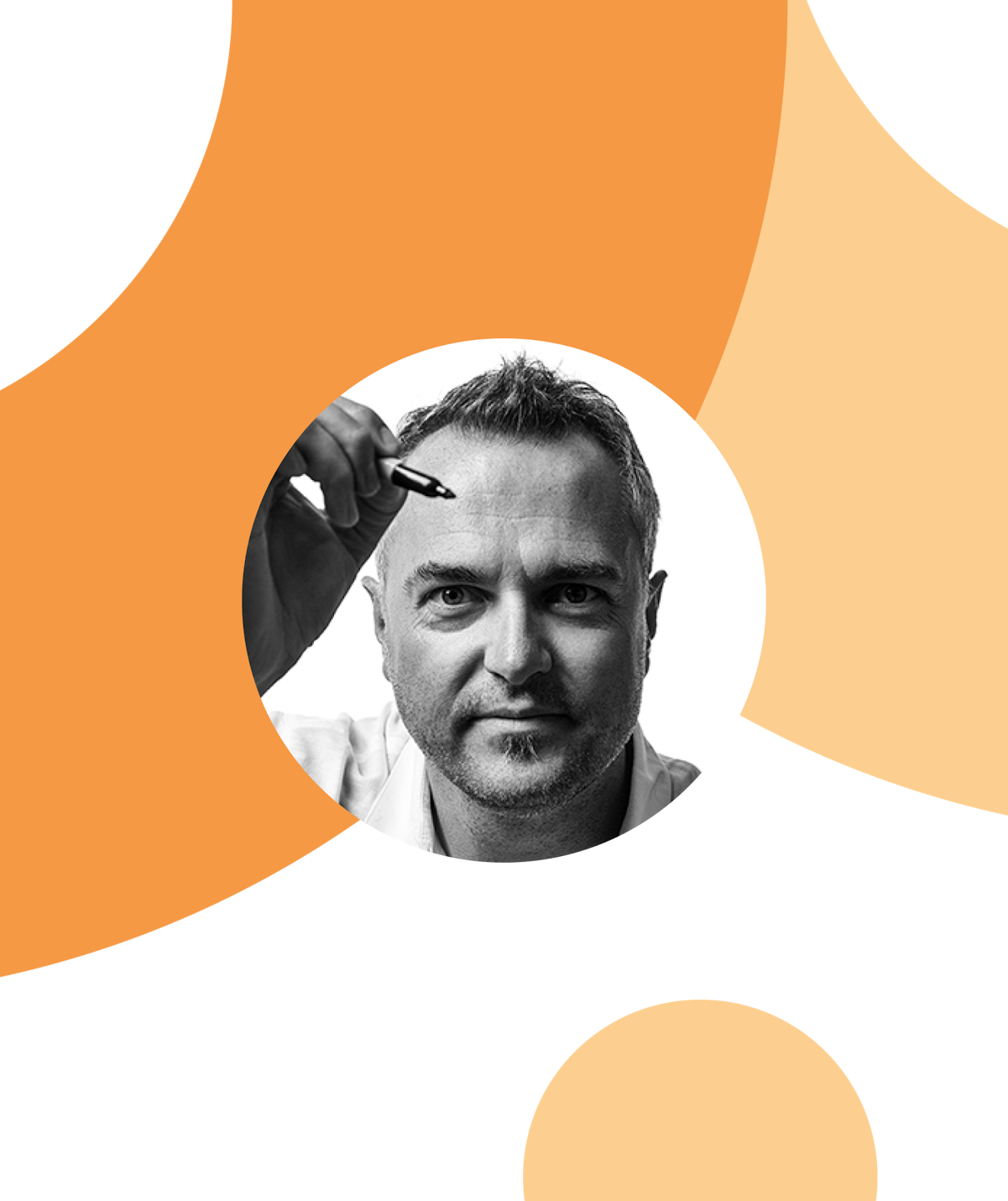Jason Giles started his career at Microsoft in the mid to late nineties, when design was just trying to get a seat at the table and came into the picture a couple of weeks before the product was shipped.
But as design grew as a discipline, Jason “grew up” alongside it—ultimately moving into design management at DirecTV, Ticketmaster, and now, UserTesting. As VP of Product Design at UserTesting, Jason leads a team of designers, writers, and researchers with the mission to enable real human insight and lead a movement for empathy. But how does one approach such an ambitious quest?
According to Jason, it all starts with learning and education, whether that's connecting with other designers, or reading the latest UX research books. Throughout his career, Jason has kept a desire for continuous learning and knowledge-sharing at the forefront of his work, using human insight to inform product decisions and advocating for new designers to take on an educator role.
As design moved from being just a stage in the product development process to an integral aspect of product success, Jason thinks learning and education are still key in ensuring organizations understand what design can do for them.
“When you think about the full breadth of what design thinking and user-centered design mean, it's so much broader than just functionality and usability. [As a designer], you're constantly on a campaign to educate companies, partners, and others on your team so that they really understand the breadth of our work,” says Jason.
We spoke with Jason about this twofold process of using human insight to build successful products and advocating for this practice internally with the same empathetic approach we apply to users: consistently learning and sharing knowledge and information.
Understanding human insight: The heart of human-centered design
To start us off, we asked Jason how he defines human insight—the smallest unit of information in the human-centered design process. According to him, an insight is “an observation made from a real human being, which could be a problem they’re experiencing or their point of view that might change the way you look at the problem space.”
Essentially, looking for human insight is a way to develop a hypothesis you have confidence in, which ultimately leads to making better decisions. “Insights help answer big questions such as, Who are you targeting? Who is this product or service optimized for? By answering these questions, insights help inform key decisions,” says Jason.
You need to be in this mindset of critically evaluating the success or failure of an idea that you have. This mindset is really crucial to maintain throughout the process.

Jason Giles, VP of Product Design @ UserTesting
An important bit to note here: gathering human insights is not the same as idea validation. “Validation research implies that you are validating the ideas that you’ve already had. You’re checking a box and that’s troublesome,” says Jason.
When working on a design or product, you should never take your ideas at face value. Instead, start with hypotheses and a learning mindset. “You need to be in this mindset of critically evaluating the success or failure of an idea that you have. This mindset is really crucial to maintain throughout the process,” says Jason.
Human insights are the backbone of a continuous learning process
When we speak about human insights helping to inform decisions—it’s not last moment decisions only. Instead, those are decisions being made early and throughout the product development process.
Every time you need to make a decision, either for a new design, feature, or product—employ a human-centered approach and go looking for customer feedback. Elaborating on this continuous learning process, Jason shares some examples of when involving customers helps:
- Audience research
Getting real human insights starts before you have a product—or a final product idea for that matter. A key part of making sure you’re building a product that your customers will want to buy is doing early research into your audience to understand their pain points and how best to solve them.
- Early concept testing
Concept testing can happen at any point along the road—whenever you need to test a design, product, or marketing idea. But it’s so much more vital to include in the early stages of the process when you’re still working on the concept. “Those concepts could be pencil sketches, a short video, or a lightweight prototype—go to people and ask for feedback. The opportunity to get feedback on your ideas can really inform your concept,” says Jason.
- Usability testing
Another opportunity to collect feedback is when you have a mid-to high-fidelity prototype or MVP (minimum viable product). This allows you to run usability tests with your product and gather insights before moving on to the development phase.
“At this point, you can actually walk people through and identify barriers in completing tasks. For example, a user might tell you ‘this is cool, but this here is a little weird.’ Don’t stop there. Ask the user to tell you more about it. ‘Why is that weird?’ Constantly try to get the why to inform design decisions.”
- Post-launch feedback
Learning from your customers doesn’t stop when you launch the product. In addition to tracking performance metrics, Jason advises looking at how a new product or service changes customer behavior.
“We don't talk a lot about when the product is out into the market. Make sure you don’t ship and forget it. How does your product or service change behavior? How was it adopted? You've just introduced something new—has it changed behavior? Keep gathering insights to make sure that your product continues to evolve as people expect,” says Jason.
3 valuable methods for gathering insights
So now that you know what human insights are and how they guide human-centered design in a continuous cycle, let’s look at ways you can gather them.
Jason highlights that the exact methods you should employ will depend on the research context and your team buildup. For instance, some teams have dedicated research departments, while others have a one-person team where one designer or researcher wears multiple hats.
Having said that, Jason gives three valuable methods for gathering human insights:
1. Listening sessions
Listening sessions are an effective generative research method for understanding your target personas, their motivations, desires, and pain points. In these types of user interviews, you gather a group of users and actively listen to them discuss their points of view on an idea or concept.
In sessions like these, Jason suggests, “looking for information that matters to your participants and what makes them different from each other. This will enable you to look at the problem through the lens of your customers.”
2. Soliciting feedback
Soliciting feedback comes not just when you have a product in the making, observes Jason, but also when identifying a product’s market need—a research step that many businesses skip.
“Whether it's new voice technology, machine learning, or blockchain, going out and getting real feedback from real people is super helpful as you start identifying a space where you think you can really innovate or ideate on or identify problems new technology can solve.”
Every time you research product ideas and market needs though, Jason recommends going in with the following mindset: “We could do all this stuff. But why should we do it? What customer problem or opportunity does this address?”
Once you identify the space to innovate in, Jason suggests you continue gathering insights throughout the product development cycle. “For instance, let's say you have a repeating benchmark on your product—you've just seen how tasks are completed. Ask yourself: ‘How do people feel when they’re using our product?’ Then, go in and get insights to understand the answer. An insight you learn could be that while people can complete tasks, their joy and emotions may actually dip when performing them.“
So by asking these questions and soliciting this feedback from real people, you have the opportunity to form a better understanding of your product or service and how you can best build it.
3. Co-creation sessions
Finally, Jason advises you to bring in customers to join the ride. As an example, Jason shares co-creation sessions they’ve had at Ticketmaster where he previously worked.
“When we were looking at investing in a new feature, we actually invited customers to join us. We flew them in and spent time doing co-creation sessions with them—we set the stage, we had markers and pens and different kinds of collateral and just riffed with them.”
Throughout the sessions, Jason and his team asked people for feedback, which got them amazing insights. “Not only did our customers share feedback in the form of ideas but also debated between them. By observing two customers talking about an idea and its pros and cons, we got an excellent foundation of feedback to start further exploring,” says Jason.
Addressing the elephant in the room: bias that comes with evaluating human insights
There’s another challenge that comes with handling human insights: keeping them free from bias. We asked Jason how to be mindful when evaluating human insights. He shared three effective tips:
- Recognize the bias
Instead of turning a blind eye to it, recognize bias. “If you can acknowledge bias, then you've identified a potential problem and so you can design solutions around that,” says Jason.
Ideally, having dedicated, professional researchers is the best option to overcome bias as these professionals are trained to be objective. “Professional researchers have trained themselves to have that objectivity. As a result, they don’t quite have the emotional attachment that some of us have with our work,” explains Jason.
However, Jason acknowledges not every team has the luxury to have researchers on board. If that’s the case with you, the next solutions will help.
- Diversify sample groups
Every time you gather a sample group of users or target personas, ask yourself: “Is the data and feedback that we’re getting back really representative of that core group?”
This is essential to make sure you source data from the correct people. A lot of our research tends to be based on assumptions that others are like us. Diversifying your sample group helps you get out of this assumption bubble, assisting you in working better with insights.
Pro tip: Don’t just ensure your user group is diverse—make sure the underrepresented samples are being heard too. To this end, Jason suggests looking not just for common patterns in feedback but for anomalies when evaluating human insights.
For instance, if five out of six people say one thing but one person points out something else, Jason recommends prodding this one person’s opinion. “Drill into that because there could be a huge opportunity there. They could be articulating something that the others either didn’t notice, took for granted, or didn't want to bring up.”
- Diversify the team that’s interpreting the results
Finally, fight bias by diversifying your team structure. “If we’re all homogenous, we’re going to tend to hear the same things, and we’re going to interpret the findings and the insights in a similar fashion,” Jason observes.
Having people from different backgrounds on the team, however, helps when it comes to analyzing and interpreting the feedback. As Jason puts it: “you are going to get nuances from different folks that you would have never gotten by yourself.”
If we’re all homogenous, we’re going to tend to hear the same things, and we’re going to interpret the findings and the insights in a similar fashion.

Jason Giles, VP of Product Design @ UserTesting
Pushing for change with an educational approach
A current challenge in the industry, according to Jason, is that companies don’t know how to maximize the value that their research and design teams bring to the table.
“You think that folks know but there are a lot of companies that are still struggling to understand how to maximize the talent that they have on the team,” Jason says. “So they invest in design teams, but they still might have mental models that are a little antiquated.”
Design thinking and user-centered design are broader than making designs more usable, more functional, and clearer. As a designer, it’s your responsibility to educate your team on the breadth of your work.

Jason Giles, VP of Product Design @ UserTesting
The solution? Take charge to address this lack of awareness by educating your team.
To that end, Jason says that his first task in a new role typically involves educating the team about the many ways designers and researchers can help—not just with product launches but with making key decisions.
When I hire designers, I tell them your other job is to be an educator. Every interaction that you have with somebody is an opportunity to educate them on what you can do, whether that’s customer empathy, design research, or something else.

Jason Giles, VP of Product Design @ UserTesting
It’s why when hiring on his team, Jason doesn’t just look for traditional skills that are mandatory for the role. Instead, he looks for people who are educators so they can help coach the ways to maximize the value of their design and research team.
“When I hire designers, I tell them your other job is to be an educator. Every interaction that you have with somebody is an opportunity to educate them on what you can do, whether that’s customer empathy, design research, or something else. There's an opportunity to really expand the definition of what we do,” says Jason.
So what does all this mean for you besides hiring the right people? How can you educate people to build momentum around human-centered design as a continuous process?
“Use the skills you already have—questioning people and being curious—to convince leadership. These are all skills that we have and apply externally all the time. We need to have that mindset shift of focusing internally and using those same superpowers that we have inside the company,” says Jason.
Taking this approach helps you correct misconceptions and bring new insights to light while developing the credibility of human insights as a continuous process. Not only does this “help with the education, but it also helps with the investment your company is making.”
Building a human-centered design culture in your organization
Collecting insights and engaging with customers shouldn’t be limited to our little [design] bubble. Having a diversity of folks engaging with customers helps them unlock and inspire their own creativity.

Jason Giles, VP of Product Design @ UserTesting
As you educate your team, work on building a stronger design thinking culture. How? Jason advises getting other teams involved in research—not just the design team.
“Collecting insights and engaging with customers shouldn’t be limited to our little [design] bubble. Having a diversity of folks engaging with customers helps them unlock and inspire their own creativity,” Jason notes.
At UserTesting, for example, lots of people from Jason’s team conduct their own research: “We've got engineers, PMs, and marketers that are actively engaging with us in talking to customers. That unlocks all sorts of new opportunities for innovation. It’s amazing when our engineers participate in the research. It inspires them as they listen to the customer share their struggles with a problem. And the next thing you know, there’s coding—prototyping solutions that maybe I, as a designer, would never ever have even considered,” says Jason.
The takeaway? Democratize research and connect with customers for more innovation and creativity. Only then can you create products that are set up for success when they get to market because customers want to use them.






